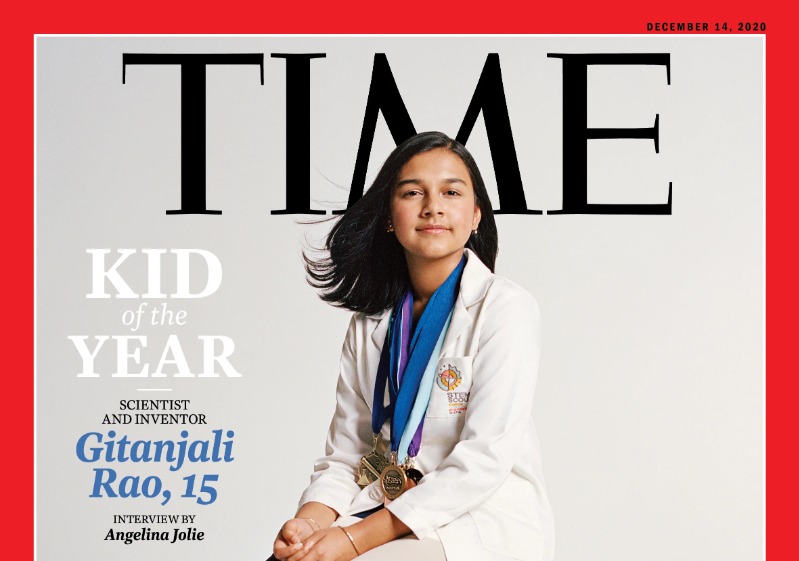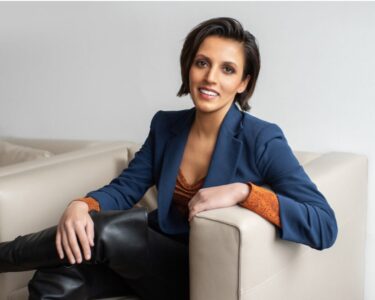BY TIME STAFF
The world belongs to those who shape it. And however uncertain that world may feel at a given moment, the reassuring reality seems to be that each new generation produces more of what these kids—five Kid of the Year finalists selected from a field of more than 5,000 Americans, ages 8 to 16—have already achieved: positive impact, in all sizes.
Read about how we picked the Kid of the Year here. And watch TIME’s Kid of the Year broadcast special on Dec. 4 at 7:30 p.m. ET on Nickelodeon.
Kid of the Year: Gitanjali Rao, 15
Lone Tree, Colo.
“Observe, brainstorm, research, build and communicate.” That is what the brilliant young scientist and inventor Gitanjali Rao told actor and activist Angelina Jolie about her process, over Zoom, from her home in Colorado, during a break in her virtual schooling. Just 15 years old, Rao has been selected from a field of more than 5,000 nominees as TIME’s first ever Kid of the Year. She spoke about her astonishing work using technology to tackle issues ranging from contaminated drinking water to opioid addiction and cyberbullying, and about her mission to create a global community of young innovators to solve problems the world over. Even over video chat, her brilliant mind and generous spirit shone through, along with her inspiring message to other young people: don’t try to fix every problem, just focus on one that excites you. “If I can do it,” she said, “anybody can do it.”
Jolie, a TIME contributing editor, is an Academy Award–winning actor and special envoy of the U.N. High Commissioner for Refugees
ANGELINA JOLIE: When did you know that science was a passion of yours?
GITANJALI RAO: I feel like there wasn’t really one specific aha moment. I was always someone who wanted to put a smile on someone’s face. That was my everyday goal, just to make someone happy. And it soon turned into, How can we bring positivity and community to the place we live? And then when I was in second or third grade, I started thinking about how can we use science and technology to create social change. I was like 10 when I told my parents that I wanted to research carbon nanotube sensor technology at the Denver Water quality research lab, and my mom was like, “A what?” [Editor’s note: they are cylindrical molecules made of carbon atoms that are very sensitive to chemical changes, and thus are good for detecting chemicals in water, among other uses.] It was just that changing factor of, you know this work is going to be in our generation’s hands pretty soon. So if no one else is gonna do it, I’m gonna do it.
AJ: I love that. So much of what my generation should be doing is just making sure we do as little damage as possible to ensure that the next generation can take the lead.
I know one of your latest innovations helps prevent cyberbullying. Could you tell me about that?
GR: It’s a service called Kindly—there’s an app and a Chrome extension—which is able to detect cyberbullying at an early stage, based on artificial-intelligence technology. I started to hard-code in some words that could be considered bullying, and then my engine took those words and identified words that are similar. You type in a word or phrase, and it’s able to pick it up if it’s bullying, and it gives you the option to edit it or send it the way it is. The goal is not to punish. As a teenager, I know teenagers tend to lash out sometimes. Instead, it gives you the chance to rethink what you’re saying so that you know what to do next time around.
AJ: So you just put it on your kids’ phones?
GR: Yeah. I put out a survey to parents, teachers and students, and I honestly expected that students don’t want to be micromanaged.
AJ: Right. My kids would be like, “Don’t touch my phone, I’ll do it myself.”
GR: No, exactly, that’s what I would be like. But a lot of the teenagers were telling me that, you know, it doesn’t seem like I’m being micromanaged; it seems like I’m being given an opportunity to learn from my mistakes. So that’s what I was superexcited about, that they understood what the goal of it was.
GR: I’m currently working on an easy way to help detect bio-contaminants in water—things like parasites. I’m hoping for this to be something that’s inexpensive and accurate so that people in third-world countries can identify what’s in their water.
Read the rest @ https://time.com/5916772/kid-of-the-year-2020/






